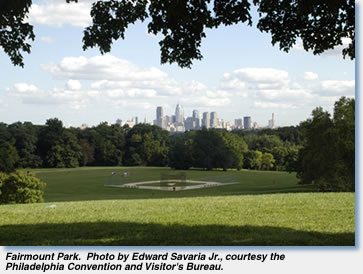 William Penn designed Philadelphia as a complex of buildings and open spaces, partly to prevent catastrophic fire and partly to encourage farm production for both local use and trade. While Philadelphia's booming prosperity and population soon filled in surveyor Thomas Holme's original spacious lots, the founder's signature remains in the city's five public squares. A magnificent Calder fountain at Logan Circle (formerly square) honors Philadelphia's three rivers and anchors the Benjamin Franklin Parkway in Center City. Franklin Park welcomes visitors arriving via the Benjamin Franklin Bridge. Rittenhouse Square (at 18th and Walnut) and Washington Square (at 7th and Walnut) host popular public parks. Two of the city's most ravishing neighborhoods, Society Hill and the Rittenhouse/Fitler Historic District, open out around these two parks. Strolling these streets past shops, magnificent houses, and gardens is delightful, even in January.
William Penn designed Philadelphia as a complex of buildings and open spaces, partly to prevent catastrophic fire and partly to encourage farm production for both local use and trade. While Philadelphia's booming prosperity and population soon filled in surveyor Thomas Holme's original spacious lots, the founder's signature remains in the city's five public squares. A magnificent Calder fountain at Logan Circle (formerly square) honors Philadelphia's three rivers and anchors the Benjamin Franklin Parkway in Center City. Franklin Park welcomes visitors arriving via the Benjamin Franklin Bridge. Rittenhouse Square (at 18th and Walnut) and Washington Square (at 7th and Walnut) host popular public parks. Two of the city's most ravishing neighborhoods, Society Hill and the Rittenhouse/Fitler Historic District, open out around these two parks. Strolling these streets past shops, magnificent houses, and gardens is delightful, even in January.
People traveling with children might want to cross the Delaware River to visit the Camden Children's Garden (3 Riverside Dr., 856-365-8733). The children's garden is a feast for the imagination, featuring scenery designed so that children can inhabit their favorite fairy tales. There's also a stunning carousel with amazing creatures that kids can ride. Check to confirm hours in January.
While you're over in Camden, I recommend having a look at the New Jersey State Aquarium (1 Riverside Dr., 800-922-6572). Visitors can pet a small shark (with supervision), watch hippos caper and dance in the new hippo tank, and walk through the open ocean tank filled with rays, big sharks, reefs, and magnificent schools of fish. You can have lunch there as well. Getting to Camden is easy on public transportation from the 8th and Market subway stop.
Now that you've seen the Delaware, you might also want to explore the Schuylkill, the city's second river. William Penn, clever promoter that he was, assigned Schuylkill frontage to investors in his colony who stayed safely in England. People who braved the Atlantic crossing got the much more valuable frontage along the bustling Delaware. The Schuylkill River provided clean water to the city into the 20th century, mainly thanks to citizens who helped create Fairmount Park, acres of public land along the riverbank that protected the water supply from industrial pollution. Today's Fairmount Park is the key to exploring the Schuylkill. Fairmount Park also includes trails along the banks of the Wissahickon, Philadelphia's third river. Besides providing a lovely natural environment, the Wissahickon trails will also take you to Historic Rittenhouse Town, a German settlement begun in 1690 around America's first paper mill.
Anyone interested in the history of botany will find many delights at Historic Bartram's Garden, home of father and son botanical team, John (1699-1777) and William (1739-1823) Bartram (54th St. and Lindbergh Blvd., 215-729-5281). John Bartram, appointed King George's Royal Botanist in America in 1765, was also elected to the Swedish Royal Academy of Science. Sited on a lovely part of the Lower Schuylkill, the Bartram House still stands and is well interpreted. Expert horticulturalists are gradually uncovering and rebuilding the landmark gardens there.
Two very unique "greenspace" resources, the John Heinz National Wildlife Refuge at Tinicum and the Morris Arboretum, lie farther afield. Southeast of the city, the Heinz refuge at Tinicum preserves the last 200 acres of what was once a 5,000+-acre natural marshland (8601 Lindbergh Blvd., 215-365-3118). Miles of trails through Tinicum introduce visitors to multiple habitats and provide year-round pleasures and beauty. The reserve survived onslaughts from developers, waste disposal planners, the airport, and Interstate 95, thanks in part to the support of the late Senator John Heinz, in whose honor it was renamed in 1991.
The Morris Arboretum in Chestnut Hill, the northwestern corner of the city, is affiliated with the University of Pennsylvania. It not only offers splendid vistas and beautiful trails but also supports scientific research into both plant culture and arcane spheres of genetics. For pure delight, you can't do better than watching the Garden Railway, an enchanting miniature train system that winds through Philadelphia scenes recreated entirely with natural materials. During the Christmas holidays, the staff dresses up the Garden Railway exquisitely with lights and music.
Greenspaces abound in Philadelphia, around the rivers and majestic squares and in surprising little pocket parks and beautiful tree-lined streets. We invite you to take a break in the outdoors to explore the "greene countrie" in today's Philadelphia.
—Shan Holt, Mid-Atlantic Regional Center for the Humanities, is a member of the Local Arrangements Committee.
Tags: Annual Meeting
Comment
Please read our commenting and letters policy before submitting.






